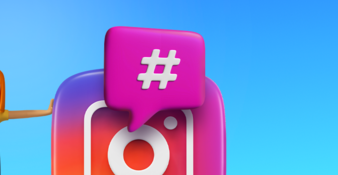3 social listening services you can offer your clients

This post is for marketing agencies.
Whether your agency is experienced and well-known or fresh and tiny, you can benefit from social listening. You can expand the services you're already offering to your clients and add new ones. For a rather affordable tool, social listening gives you enormous opportunities.
In this post, you'll learn which social listening services you can offer your clients and how to perform them.
But first, a quick note on what social listening is:
Social listening is a process of finding all mentions of a given keyword(s) (e.g., brand, product, industry, CEO, etc.) on social media and the rest of the Internet.
A social listening tool is used for that: it finds mentions on any specified platforms and lets you reply to these mentions, as well as analyze the data.
Here are the three social listening services I want to talk to you about :
1. Brand reputation analysis
2. Competitor analysis
3. Influencer marketing
Brand reputation
First thing you do when you get a client - you make a sketch of their brand. You look up how much traffic it gets, how many customers the company has, what's the SEO and SMM situation, etc.
An analysis of the brand's reputation isn't that simple. However, it's just as important.
The first thing to do is to measure the sentiment behind the brand on social media, news sites, blogs, and forums. That's where a social listening tool comes in. In Awario, you can create an alert for your client's brand and see the breakdown of positive, negative, and neutral mentions on the Dashboard.
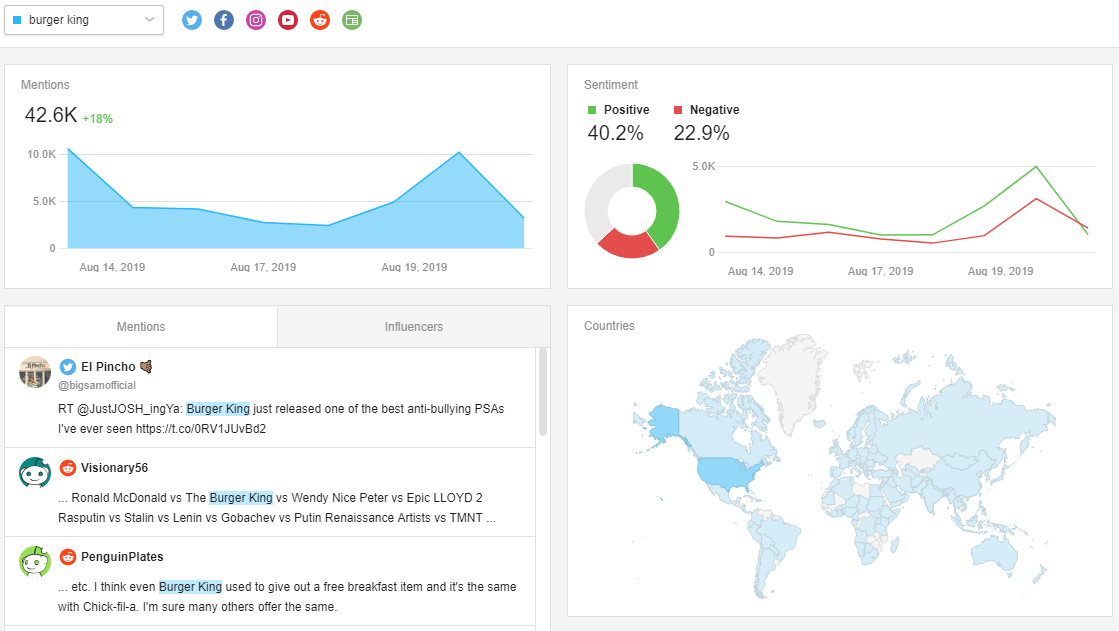
You can provide your clients with two metrics: one that covers the brand's reputation on social media and another one that covers the brand's reputation on news and blogs. This can be handy for assessing the actual damage after some sort of scandal that was covered by the news.
Once you know the overall brand reputation (e.g., in the example above, Burger King is perceived twice more positively than negatively online), you can dive into the actual conversations and see what's considered positive and negative about the brand. You can also go straight to the publishers and see what the media says about the brand:

Finally, you can look at the topic cloud that tells you which words are used alongside the brand most often. This will also give you an idea about the word-of-mouth behind the brand. For example, this is what is being said alongside "Burger King":

Now you know the following about the brand's reputation:
1. How it's seen by the audience on social media (overall data and specific cases)
2. How it's seen by the media (overall data and specific cases)
3. The main topics that are discussed alongside the brand.
This is enough for a quick report. However, there's more you can do.
For example, you can analyze how the brand's campaigns were perceived by their audience. To do that, create an alert for a campaign (use its slogan or hashtag, as a keyword) and look at the number of mentions, the sentiment behind it, main topics that came up alongside the brand.
Creating several alerts for several brand campaigns from the brand's past and comparing them, which you can do in Awario, will give you a clear idea of which approach is more effective with your client's audience.
Competitor analysis
Competitor analysis is one of the hardest tasks agencies have to do when they get a new client. To make an informed decision about your client's marketing strategy, you have to evaluate the marketing strategies of their main competitors. Surely, social listening isn't everything you have to use to have a comprehensive view of your client's competitors. Social listening helps you with a specific part of the competitive analysis - the part that tells you about the client's and competitor's customers and brand awareness.
Share of voice
With social listening, you will see each brand's share of voice - it will give you a clear idea about what part of the market is taken by your client's brand and what part of the market is taken by their competitors. To get the share of voice metrics, add a couple of alerts for your client's direct competitors, give the tool some time to collect the data, and jumpt to Alert Comparison to see the result. Share of voice metrics looks like this:

Competitors' reputation
You can compare brands' sentiments, mentions' growth, mentions' reach (i.e. brand awareness), and key topics that are discussed with each brand. This will give you a clear idea on where the client's brand stands against its main competitors. Here's, for example, how the duchesses of Great Britain compare by sentiment and the number of mentions in a given period of time.
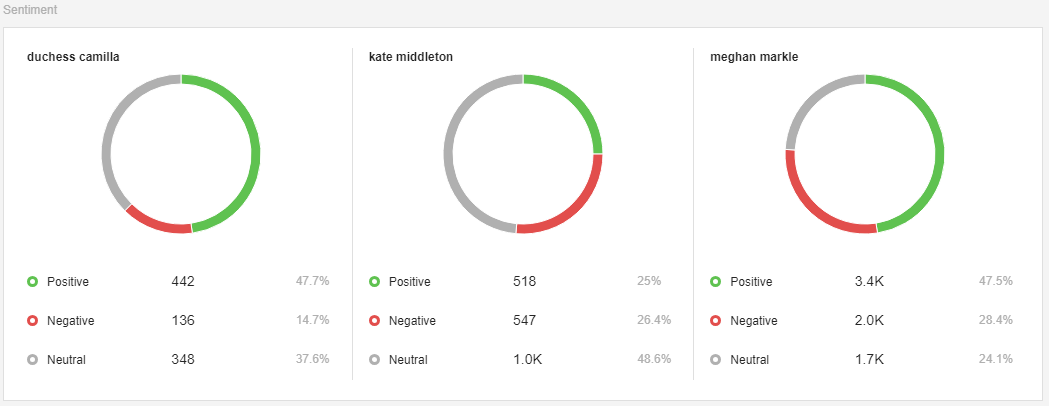
Geography
You can get a clear view of the geography of the online presence of your client's brand and of their main competitors. In some cases, this information is unexpected and useful. For example, you might find that the competitor's brand is popular in a country you haven't thought of pursuing. The location comparison looks like this:
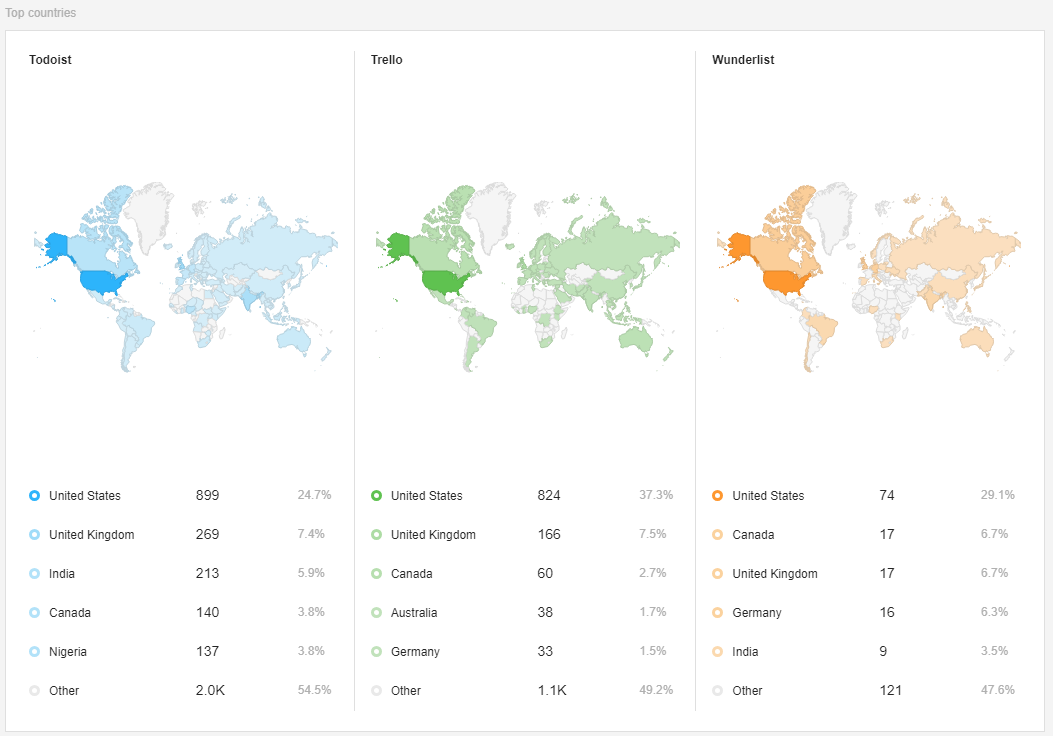
You get the same breakdown by languages.
Social media platforms
The first question of social media marketing is which social media platforms to focus on. Social listening will tell you what platforms the competitors' audience hangs out on the most. As your client and their competitors share the same target audience, this will help you decide where to focus and how to build an SMM strategy.
Influencer marketing
Influencer marketing is one of the hottest marketing trends. As an effective strategy and the ever-increasing practice, it's a service your clients will be extremely happy to have. Without social listening, you're left with the most important (and the most expensive) influencers that everyone knows about.
With social listening, however, you can reach micro-influencers - the social media influencers that are famous only in a specific niche. These are the people you need - while their reach is not as high as it can be (we all know about PewDiePie and the Kardashians but none of us can hire them), micro-influencers have a dedicated audience that actually trusts their opinion.
Industry influencers
Collaborating with industry influencers doesn't always go the same way. It can require payment, mutual favors, or even just friendship that you build along the way. The real challenge is finding micro-influencers, and this is where social listening comes in.
To find micro-influencers, create an alert in Awario for the client's industry. Use the words that best describe the industry, give the tool some time to find mentions, and then go to the Influencers tab to see the list of relevant influencers.

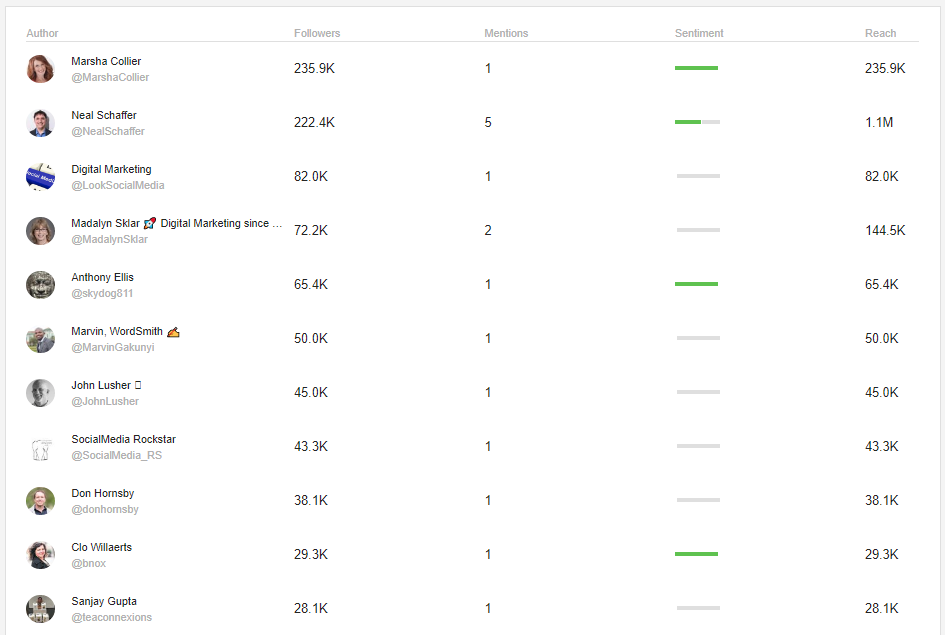
Go the profiles of the ones you find interesting, and start with influencer marketing!
Brand advocates
And finally, the kind of influencers that is absolutely vital to find are brand advocates. If your client's brand hasn't appeared yesterday, there's a high chance someone who's an expert in the given niche has already said something positive about your client's brand. It's important they aren't left unnoticed. Some dialogue and maybe some mutual favors, and this person is a brand advocate selling the product to all his followers and raising brand awareness for your client like no ad can do in our ad-saturated world.
Finding brand advocates in Awario requires the following process: set up an alert for your client's brand, wait for the tool to gather some data, then go to the Influencers tab and see the list of brand advocates sorted by their influence.
In case something is not 100% clear or you need help, please see Awario's help center or contact our super-friendly support.
These are not all services you can offer with social listening. However, the value of these three will be apparent to your clients straight away, so it's a good place to start.
By signing up I agree to the Terms of Use and Privacy Policy












